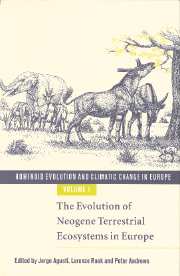Book contents
- Frontmatter
- Contents
- List of contributors
- Acknowledgements: The European Science Foundation
- 1 Introduction
- PART I Palaeogeography of the circum-Mediterranean region
- PART II Miocene mammalian successions
- 5 A critical re-evaluation of the Miocene mammal units in Western Europe: dispersal events and problems of correlation
- 6 Large mammals from the Vallesian of Spain
- 7 Trends in rodent assemblages from the Aragonian (early–middle Miocene) of the Calatayud-Daroca Basin, Aragon, Spain
- 8 The Late Miocene small mammal succession from France, with emphasis on the Rhône Valley localities
- 9 Late Miocene mammals from Central Europe
- 10 An overview on the Italian Miocene land mammal faunas
- 11 The Miocene large mammal succession in Greece
- 12 Chronology and mammal faunas of the Miocene Sinap Formation, Turkey
- 13 The Late Miocene small mammal succession in Ukraine
- PART III Palaeoenvironments: non-mammalian evidence
- PART IV Palaeoenvironments: mammalian evidence
- Index
9 - Late Miocene mammals from Central Europe
from PART II - Miocene mammalian successions
Published online by Cambridge University Press: 15 December 2009
- Frontmatter
- Contents
- List of contributors
- Acknowledgements: The European Science Foundation
- 1 Introduction
- PART I Palaeogeography of the circum-Mediterranean region
- PART II Miocene mammalian successions
- 5 A critical re-evaluation of the Miocene mammal units in Western Europe: dispersal events and problems of correlation
- 6 Large mammals from the Vallesian of Spain
- 7 Trends in rodent assemblages from the Aragonian (early–middle Miocene) of the Calatayud-Daroca Basin, Aragon, Spain
- 8 The Late Miocene small mammal succession from France, with emphasis on the Rhône Valley localities
- 9 Late Miocene mammals from Central Europe
- 10 An overview on the Italian Miocene land mammal faunas
- 11 The Miocene large mammal succession in Greece
- 12 Chronology and mammal faunas of the Miocene Sinap Formation, Turkey
- 13 The Late Miocene small mammal succession in Ukraine
- PART III Palaeoenvironments: non-mammalian evidence
- PART IV Palaeoenvironments: mammalian evidence
- Index
Summary
Introduction
The Vallesian and Early Turolian constitute a period of considerable faunal changes in Central Europe and even show a complete faunal turnover in some families. On the genus level, this period represents the time when the Middle Miocene fauna – still predominant during MN 9 – vanishes and immigrants appear which provide a modern stamp and often include ancestors of the extant fauna. Zone MN 10 is actually the crucial period of the faunal turnover. Therefore, the biostratigraphical subdivision does not follow the same standard throughout the present range charts: zone MN 9 is not further subdivided although there is not much doubt that Götzendorf takes a position pretty close to the MN 9 – MN 10 boundary (see Rögl et al., 1993) while Hammerschmiede and Vösendorf occupy a more basal position within MN 9. On the other hand zone MN 10, although obviously a rather short period in absolute chronology, is subdivided for micromammals into an earlier and later component in order to assess faunal changes during that critical interval. The penecontemporaneous Early Turolian localities Eichkogel and Dorn-Dürkheim 1 are listed for micromammals separately to provide a basis for inferences about latitudinal differences.
Large mammals
There are six groups of Vallesian macromammal sites known from Central Europe that are geographically, stratigraphically, and/or taphonomically different. All are located south of the Main River (Fig. 9.1).
- Type
- Chapter
- Information
- Hominoid Evolution and Climatic Change in Europe , pp. 165 - 190Publisher: Cambridge University PressPrint publication year: 1999
- 12
- Cited by

